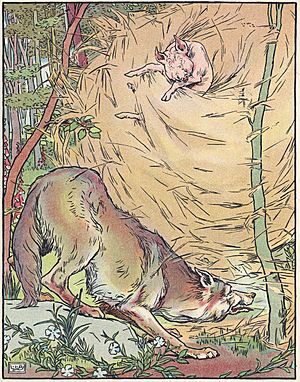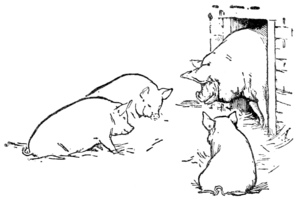The Three Little Pigs facts for kids
Quick facts for kids The Three Little Pigs |
|
|---|---|

The wolf blows down the straw house in a 1904 adaptation of the story. Illustration by Leonard Leslie Brooke.
|
|
| Folk tale | |
| Name | The Three Little Pigs |
| Data | |
| Aarne–Thompson grouping | 124 |
| Country | England |
"The Three Little Pigs" is a famous fable about three pigs who build their houses from different materials. A Big Bad Wolf tries to blow down their homes. He easily destroys the first two pigs' houses, which are made of straw and sticks. But he cannot knock down the third pig's house, which is built from strong bricks.
People have been telling this story for a very long time. The first printed versions appeared in the 1840s. The most well-known version was published in English Fairy Tales by Joseph Jacobs in 1890. The story teaches important lessons about hard work and planning. Many phrases from the story have become common in Western culture.
Contents
The Original Story
The story of "The Three Little Pigs" was first written down in books like The Nursery Rhymes of England around 1886. The version most people know today came from English Fairy Tales by Joseph Jacobs in 1890. An even older version from 1853, found in Dartmoor, Devon, England, featured three small pixies and a fox instead of pigs and a wolf.
In the classic story, the three little pigs leave their mother's home to find their own way in the world.
- The first pig quickly builds a house of straw. The wolf comes and blows it down, then eats the pig.
- The second pig builds a house of sticks. The wolf blows this house down too, though it takes more effort, and also eats the second pig.
Each time, the wolf and pig say famous lines:
"Little pig, little pig, let me come in."
"No, not by the hair on my chinny chin chin."
"Then I'll huff, and I'll puff, and I'll blow your house in."
- The third pig builds a strong house of bricks. The wolf tries his best, but he cannot blow down this house.
The wolf then tries to trick the clever third pig into meeting him outside. But the pig is always smarter and gets to the meeting places early. Finally, the angry wolf decides to climb down the chimney. The smart pig lights a fire under a pot of water in the fireplace. The wolf falls into the hot water and dies.
Different Ways the Story is Told
Over the years, "The Three Little Pigs" has been told in many different ways. In some versions, the first two pigs are not eaten by the wolf. Instead, they run to their brother's or sister's brick house for safety. In these stories, the wolf might just run away after failing to blow down the brick house, or he might faint. This means all three pigs survive.
The story uses a common writing trick called the rule of three. This means things happen three times, often with the third time being the most important or successful. Here, the third pig's brick house is the only one strong enough to stop the wolf.
Some older versions of the tale appeared in Uncle Remus: His Songs and Sayings (1881) and Nights with Uncle Remus (1883) by Joel Chandler Harris. In these stories, Brer Rabbit takes the place of the pigs.
In The Green Fairy Book (1892) by Andrew Lang, the pigs have names: Browny, Whitey, and Blacky. This version also explores what each pig is like. The bad guy in this story is a fox, not a wolf. The pigs' houses are made of mud, cabbage, or brick. The third pig, Blacky, even rescues his siblings from the fox's den!
The Three Little Pigs in Movies and TV
The story has been made into many cartoons, movies, and TV shows.
Animated Cartoons
- The 1933 Silly Symphony cartoon by Walt Disney, called Three Little Pigs, is very famous. The pigs are named Fifer Pig, Fiddler Pig, and Practical Pig. The first two pigs are shown as playful and a bit careless. In this version, they escape the wolf when their houses are blown down. The wolf doesn't die but gets burned and runs away.
* This cartoon was so popular that Disney made several sequels: The Big Bad Wolf (1934), Three Little Wolves (1936), and The Practical Pig (1939). * In 1941, parts of the film were used in The Thrifty Pig, where Practical Pig builds his house from Canadian war bonds, and the wolf represents Nazi Germany. * Fiddler Pig, Fifer Pig, and Zeke the Wolf also appeared in the movie Who Framed Roger Rabbit.
- Other cartoons have also told the story, sometimes with a twist:
* Blitz Wolf (1942) by Tex Avery showed the wolf as Adolf Hitler during wartime. * Warner Bros. made cartoons like Pigs in a Polka (1943) which used classical music, and The Windblown Hare (1949) with Bugs Bunny. * The Turn-Tale Wolf (1952) told the story from the wolf's side, making the pigs seem like the bad guys. * The Three Little Bops (1957) featured the pigs as a jazz band.
Movies and TV Shows
- 3 Pigs and a Baby (2008) is an animated movie based on the story.
- The three pigs and the wolf are popular characters in the four Shrek films and TV specials like Shrek the Halls.
- In 1985, the story was retold in Shelley Duvall's Faerie Tale Theatre.
- The 1992 Green Jellö song, Three Little Pigs, was made into a claymation music video.
- In the PBS Kids show Super Why, Pig (Littlest Pig) is a main character. He is the youngest of the three little pigs and can turn into Alpha Pig with Alphabet Power.
- In 2018, the story was part of the TV series Tell Me a Story, which mixed different fairy tales together.
The Three Little Pigs in Books
- The True Story of the 3 Little Pigs! (1989) is a funny book told from the wolf's point of view. He says the whole thing was a misunderstanding! He just wanted to borrow some sugar and had a bad sneezing fit.
- The Three Little Wolves and the Big Bad Pig (1993) flips the story around. Here, three little wolves build houses, and a big bad pig tries to destroy them. The pig is very strong, but in the end, he changes his ways and becomes friends with the wolves.
- In 2019, Simon Hood published a modern version of the story with both male and female pig characters. The language and illustrations were updated, but the main plot stayed the same.
- The Three Little Pigs are often seen in Monica and Friends comics, especially in stories about Smudge, who loves pigs.
See also
 In Spanish: Los tres cerditos para niños
In Spanish: Los tres cerditos para niños


